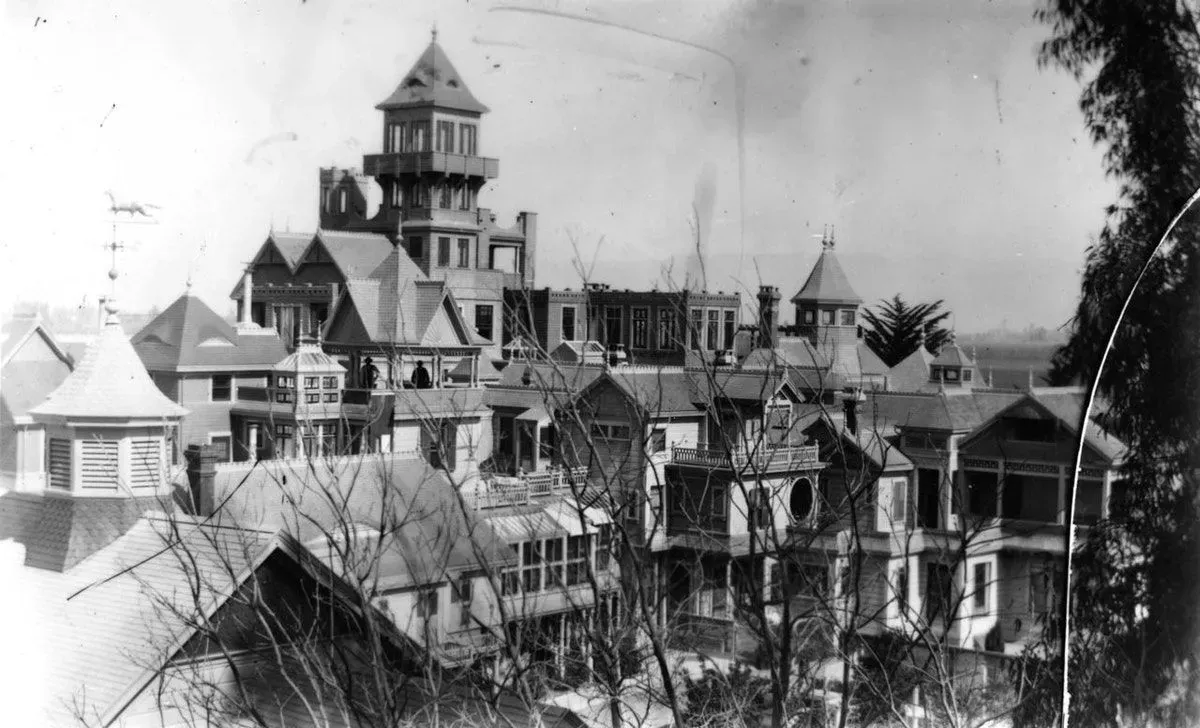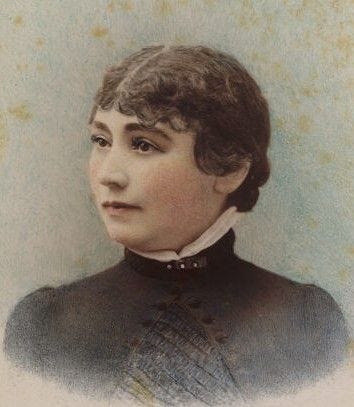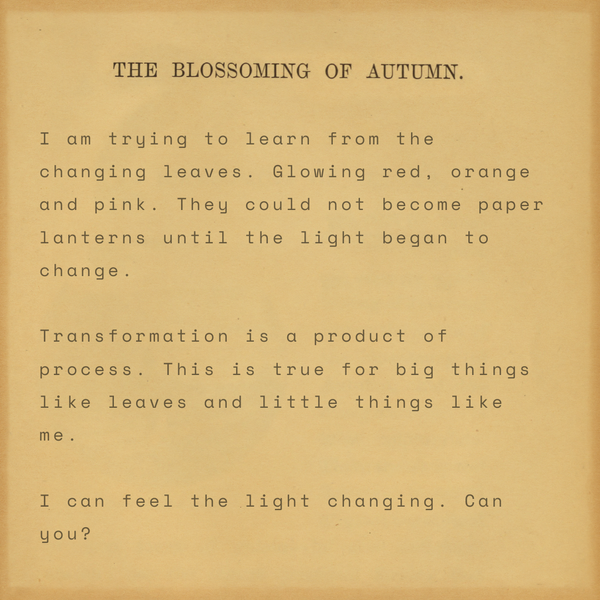The Winchester Mystery House
If there’s one thing we love more than a haunted house, it’s a haunted woman.

If there’s one thing we love more than a haunted house, it’s a haunted woman. We think houses are haunted because of things that happened in them. We think women are haunted because of bad things they’ve done or allowed to occur. A haunted woman gets what she deserves. And my goodness, we love to watch a woman getting what she deserves.
A few types of haunted women come to mind. If we’re going fictional, there’s no better example than Lady Macbeth. After she learns that the three weird sisters prophesied her husband would be king, she sets about making it so. She drugs the king’s attendants, lays out the knives, waits and watches while her Macbeth kills King Duncan. A force before the murder, she fades from Shakespeare’s play once she becomes Queen. We only get glimpses of her, tremulous, afraid and haunted - she can never get the blood of her work off her hands. She dies off-stage by suicide. We like women to be haunted by their circumstances too.
Shirley Jackson, the writer who gave us The Haunting of Hill House, was haunted by the twin demons of a crushing childhood and cursed marriage. When we read her horror stories, we lap up the blood wrung out of domestic expectations that ravage even the most caustic and concise women.
Perhaps our most beloved haunted woman is one that is real and is literally haunted. Maybe this why why Sarah Winchester endures. Well before she died in 1922, Sarah was established by rumoring neighbors and runaway newspapers as a haunted woman in a haunted house. Born in 1839 in Connecticut, Sarah grew up to be a polyglot with a pretty face. She was known to be affable, clear-headed and savant-like in her knowledge. It’s perhaps no surprise that when she married, she married well. She married into the Winchester family, whose immense wealth was owed to the Winchester repeating rifle, one of the first guns to allow a user to fire multiple shots before having to reload ammunition.
While the money didn’t hurt, all reports seem to indicate that she and William Winchester truly loved each other. They lived a full life together - tackling architecture projects in between pregnancies that kept ending in miscarriages. After years of miscarried babies, Sarah’s body finally carried one to term. Born in June of 1866, the Winchesters named their daughter Annie. Annie was very loved and only lived for six weeks. She had a disease that kept her body from absorbing nutrients from food. Our Sarah had to hold her baby while she slowly starved to death. After they buried their daughter, there were no more children. William and Sarah lived together, measuring their time through projects and philanthropy for the next fourteen years.
When William died of tuberculosis in 1881, Sarah was a 42 year old woman with a 50% ownership of Winchester shares. She endowed a hospital in Connecticut that still exists today and then took the rest of her wealth, a few sisters (and their families) and moved to California. She set up her family members in various lovely homes before choosing her own - a farmhouse in San Jose, California.
The home she bought was nice but not what one expected for a woman of her status. When she began renovating, it made sense. No one would have blinked an eye if one the wealthiest women in the world chose to enlarge and renovate it, especially if all the enlarging was followed by a housewarming party with fine wine and plenty of opportunities to observe the mistress of the house. Women are less likely to be gossiped about maliciously if they provide opportunities for genial gossip warmed by their own hospitality.
It’s easy to picture Sarah’s neighbor’s picking out the clothes they’d wear to the party when the tearing down and hammering started at her estate. The effort was wasted, because the hammers never stopped and the wine was never served and Sarah never offered herself up for their observation.
The rumors about the tiny woman, Sarah was only 4’10”, and her sprawling house, it eventually topped 24,000 square feet, started once the neighbors realized they would not be welcomed in. The story they told about her then is the story they tell about her now.
Devastated by the loss of her husband she went to a medium, hoping to connect with both William and Annie. The medium told her that she could not reach her husband or daughter but could see thousands of souls lost to the lead bullets of Winchester repeater rifles. The medium told Sarah that the only way to protect herself from these spirits, to appease them, was to build a house large enough to house them and labyrinthine enough to keep them confused. The building must never stop - not even for a moment - if the spirits were to be kept at bay.
Sarah believed the medium and went out west to begin building a house big enough for the restless souls of murdered spirits. The construction went on twenty-four hours a day, seven days a week for forty years. She held seances each night at midnight. There were windows in her floors, staircases that switched back six times to climb a few feet, doors that opened into the air and staircases that led to nowhere. She was a mad woman who spent her entire blood fortune placating vengeful spirits.
It’s a good story. Too good to be kept between neighbors. Too good to be kept in archives of newspapers from the time. It’s such a good story you can pay $39.99 to hear it told by a guide as you take a tour of Sarah’s house. They walk you through the home she built and tell you about her grief and her guilt and her ghosts.
The Winchester Mystery House Tour starts in a long hallway, winds through the house, takes you out through a parlor decorated with movie memorabilia from the Winchester movie starring Helen Mirren, then has you exit through a gift shop with mugs and puzzles with Sarah’s house on them. I’ve been on the tour a few times. Each time I left more unsettled. Not because of potential ghosts but because this dramatization and exploitation of Sarah’s life and Sarah’s house is just so damn predictable.
There is no record of her ever meeting with a medium. Sarah did not spend her entire fortune on the house. It cost about $5 million dollars. She was worth over half a billion dollars. Work on the house did go on throughout her lifetime but it was not incessant. There are records of stops and starts. There is contemporary correspondence that indicates Sarah was more concerned with keeping craftsmen and construction workers employed than any ghosts subdued.
This concern for the working class fits in with her treatment of her staff - they were incredibly loyal to her, incredibly well-paid and each got a piece of her estate when she died. If she only spent less than one percent of her wealth on her grand building project, where did her money go? Some went to staff, a little went to family, but not much. Even her favorite niece only got the contents of the house plus a $200,000 trust. Nearly all of it went to her true passion - philanthropy.
Her house was sold to the highest bidder - a man who lived in her community, who opened it up for tours within a year of her death. We like women to be guilty and we like them to pay for her guilt. Perhaps in the context of today’s view on guns, that guilt is logical. But Sarah wasn’t the heiress to a gun fortune in 2020, she was the heiress to a gun fortune in the late 1800s. There’s no evidence Sarah dealt with real or philosophical demons because of how her fortune was built.
The draw to the house makes sense. It is odd and sprawling. There is a window in a floor, stained glass windows cite obscure Shakespeare quotes, the number thirteen repeats either on purpose or on accident several times throughout the house - from the number of bathrooms to a favored Sarah Winchester designed window with thirteen stained glass points. It’s not spooky, it’s delightful. One imagines Sarah tossing aside the architecture books she studied with her husband and pursuing whim and wonder over established rule. Those odd stairs that switch back and forth to climb a few feet? They were built to protect her severely arthritic knees.
The doors and stairways leading to nowhere are the result of damage to the house during the 1906 San Francisco earthquake. Whole portions of the house broke away in the tumult, an entire story toppled, and much was sealed off instead of rebuilt. She didn’t need to rebuild. She had plenty of room. The repairs and oddities left behind by the 1906 earthquake are used as proof of her madness in every paid tour.
Isn’t this what always happens when women are shaken by circumstance? When they decide they won’t rebuild for appearance sake, that they’ll just move on? The unfinished places and the sealed doors are always used against them.
There’s invention in the house too. Sarah designed kitchen elements meant to aid and protect the women working in it. It’s especially frustrating to me that she spent her life depicted as a woman devoted to gaslighting ghosts, when she really spent much of her time and money easing the lives of the people living in her sphere. She provided for her sisters' families. Paid for the education of her relatives and confidants.
She didn’t even live in her house for most of her last few years, she lived near a beloved sister. Still the work went on and the people doing it stayed paid. If anyone bothered to read the writings of the people who actually knew her - from the gardener to the family lawyer - a different sort of picture emerges. She was in command of her mind and in command of her time. She was a fiercely private, flawed, brilliant, odd, tragic and charitable woman of her time.
And here, I suppose, is where I must face that the reason I love Sarah so much is because, well, I do think she was a haunted woman. I love a haunted woman too. She was not haunted by spirits but haunted in the way so many of us are. A woman who has endured miscarriages, who has held her baby while she literally wasted away, who has buried a husband is a woman haunted by sorrow.
A woman who chooses to build what she likes, who does not court popular opinion, who establishes borders and decides who will cross them is a woman haunted by rumor. A woman who creates anything that outlasts her is a woman haunted by later generations determined to profit off the flattening of her full life.
There is one rumor they tell at the end of Sarah’s house tour that feels true. The guide takes a deep breath and tells you that when the house was being cleared out, a safe was found in one of Sarah’s favorite grand rooms. In that safe was another safe. And in that second safe was one more safe. When the third safe was opened, four items were found. The obituaries of William and Annie. A lock of William’s hair. A lock of Annie’s hair. These four things in the heart of her house, that makes sense to me. A haunted woman building a house that she could never get quite big enough to hold the love for the ones she lost.

When I think of Sarah like this, I can almost see her, almost feel her, almost…well, it’s enough to leave me feeling almost haunted by her. Haunted maybe until I tell her story well. I’ve told it now. Is it enough? When I peer beyond her form, the one that is there except it isn’t, I can see there are others waiting. So many women waiting. It’s overwhelming. I could write every day, every hour without ever stopping and still not have the words to hold them all.




